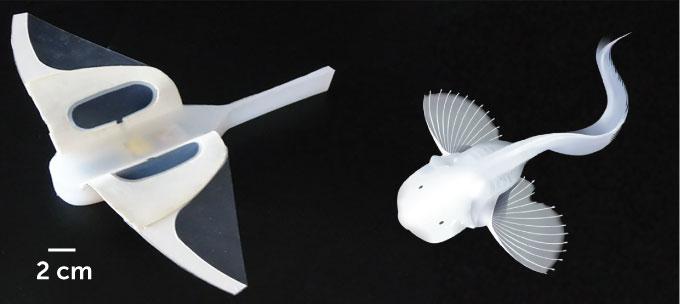
3 minute read
Underwater Soft Robot Developed to Withstand Crushing Pressures
PHYSICS
Underwater Soft Robot Developed to Withstand Crushing Pressures
Advertisement
Heather Morrison
Over 80 percent of our oceans are still unexplored. However, our limited knowledge is enough to show us their importance in the workings of our planet. The ocean produces over half of the world’s oxygen and absorbs 50 times more carbon dioxide than our atmosphere through photosynthesis of phytoplankton, kelp and algal plankton. Exploration of deep-sea trenches has shown that they are teeming with microbial life, suggesting that these trenches play a significant role in the Earth’s carbon cycle. Further exploration will be able to provide more insight into the complicated systems which run our planet and the ever-looming question: where did we come from?
However, the overriding problem of the high pressure within these trenches remains. So far, we have overcome the increasing pressure of deep-sea exploration by reinforcing submersibles with rigid metal frames to stop them from crumpling. While useful, this method of withstanding pressure makes the vessels increasingly bulky and cumbersome. This led roboticist Guorui Li of Zhejiang University in Hangzhou, China to develop a machine inspired by the deep-sea snail fish. What this fish lacks in beauty, it makes up for in its extremely well adapted body to life in the Marina trench. The fish has soft bones, and its skull is not completely fused together. This allows the pressure on the skull to equalize, enabling it to withstand high pressures. Li and his team replicated the anatomy of the deepsea snail fish to make his robot. By distributing the electronics of the robot farther apart and encasing them in soft silicone to keep them from touching they were able to prevent the electronic components from scraping and damaging one another under the pressure. They further designed a soft body which partially resembles the snailfish and is filled with a synthesized version of the water goo inside the fish’s body, adding to robot’s buoyancy and helping it to swim more efficiently. They even created artificial muscles which flap the fins of the fish.
The team performed a series of tests on their prototype. First, the robot swam freely at 70 meters deep in a lake, then at about 3,200 metres deep in the South China Sea. The robot was then tested at the bottom of the Challenger Deep, however in this trial it was held by the extendable arm of a deep-sea lander. All these results are extremely promising for the future of deep-water exploration and research, but much more research still needs to be done before these robots are deployable. Cecilia Laschi of the National University of Singapore and Marcello Calisti of the University of Lincoln in England have commented that the robotic fish swims more slowly than other underwater robots and does not yet have the power to withstand powerful underwater currents. However, it “lays the foundations” for future such robots.
Biomimicry, using nature as an inspiration to innovate, is extremely common and successful in robotics. famous examples of this are SpotMiniby Boston dynamics, a robot inspired by dogs and designed to manoeuvre rough terrain and CRAM by University of California, a robot that was inspired by cockroaches and their abilities to disappear down cracks that seem far too small for them to help in search and rescue missions where the site is hard to access. The success of biomimicry is
The design of the new soft robot (left) was inspired by the deep-sea snailfish (illustrated, right)

Soft robot navigating the South China Sea

PHYSICS
unsurprising, since these designs have been time-tested through natural selection, resulting in organisms best adapted to their environment. By appreciating and taking inspiration from these remarkable animals around us, their million-year evolution can allow us to explore places we could never go by ourselves. Sources:
https://www.sciencenews.org/article/new-soft-robot-snailfish-crushing-pressures-deep-ocean https://www.nature.com/articles/s41598-018-32757-9?WT.feed_name=subjects_soft-materials https://pubmed.ncbi.nlm.nih.gov/33658693/







